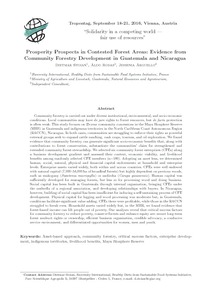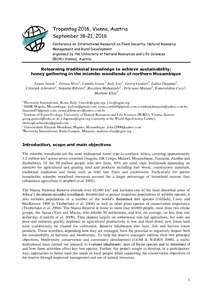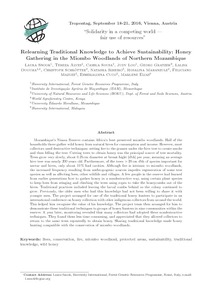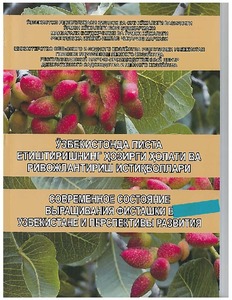Location
Bioversity International is a global research-for-development organization. We have a vision – that agricultural biodiversity nourishes people and sustains the planet.
We deliver scientific evidence, management practices and policy options to use and safeguard agricultural and tree biodiversity to attain sustainable global food and nutrition security.
We work with partners in low-income countries in different regions where agricultural and tree biodiversity can contribute to improved nutrition, resilience, productivity and climate change adaptation.
Members:
Resources
Displaying 61 - 65 of 184Prosperity prospects in contested forest areas: evidence from community forestry development in Guatemala and Nicaragua
Tropentag, September 18-21, 2016, Vienna, Austria
“Solidarity in a competing world —
fair use of resources”
Prosperity Prospects in Contested Forest Areas: Evidence from
Community Forestry Development in Guatemala and Nicaragua
Dietmar Stoian
1
, Aldo Rodas
2
, Jessenia Arguello
3
1
Bioversity International, Healthy Diets from Sustainable Food Systems Initiative, France
2
Ministry of Agriculture and Livestock, Guatemala, Natural Resources and Agrotourism,
3
Relearning traditional knowledge for sustainability: honey gathering in the Miombo Woodland of Northern Mozambique
Mozambique's Niassa Reserve contains Africa's best preserved miombo woodlands. Half of the households there gather wild honey from natural hives for consumption and income. However, most collectors used destructive techniques: setting fire to the grasses under the hive tree to create smoke and then felling the tree. Cutting trees to obtain honey was the principal source of tree mortality. Trees grow very slowly, about 0.25 cm diameter at breast hight [dbh] per year, meaning an average hive tree was nearly 200 years old.
Relearning traditional knowledge for sustainability: honey gathering in the Miombo Woodland of Northern Mozambique
Mozambique's Niassa Reserve contains Africa's best preserved miombo woodlands. Half of the households there gather wild honey from natural hives for consumption and income. However, most collectors used destructive techniques: setting fire to the grasses under the hive tree to create smoke and then felling the tree. Cutting trees to obtain honey was the principal source of tree mortality. Trees grow very slowly, about 0.25 cm diameter at breast hight [dbh] per year, meaning an average hive tree was nearly 200 years old.
Results of study of genetic diversity of pistachio and replenishment of its breeding genepool in Central Asia
Report on the main activities undertaken and preliminary findings emerging from research on the CGIAR Targeting Agricultural Innovations and Ecosystem Services in the northern Volta basin (TAI) project
The CGIAR Water, Land and Ecosystems research project on Targeting Agricultural Innovations and Ecosystem Services in the northern Volta basin (TAI) is a two year project (2014-2016) led by Bioversity International in collaboration with 11 institutes: CIAT, CIRAD, International Water Management Institute (IWMI), King’s College London (KCL), SNV World Burkina Faso (SNV), Stanford University, Stockholm Resilience Centre (SRC), University of Development Studies Ghana (UDS), University of Minnesota, University of Washington, and the World Agroforestry Institute.






